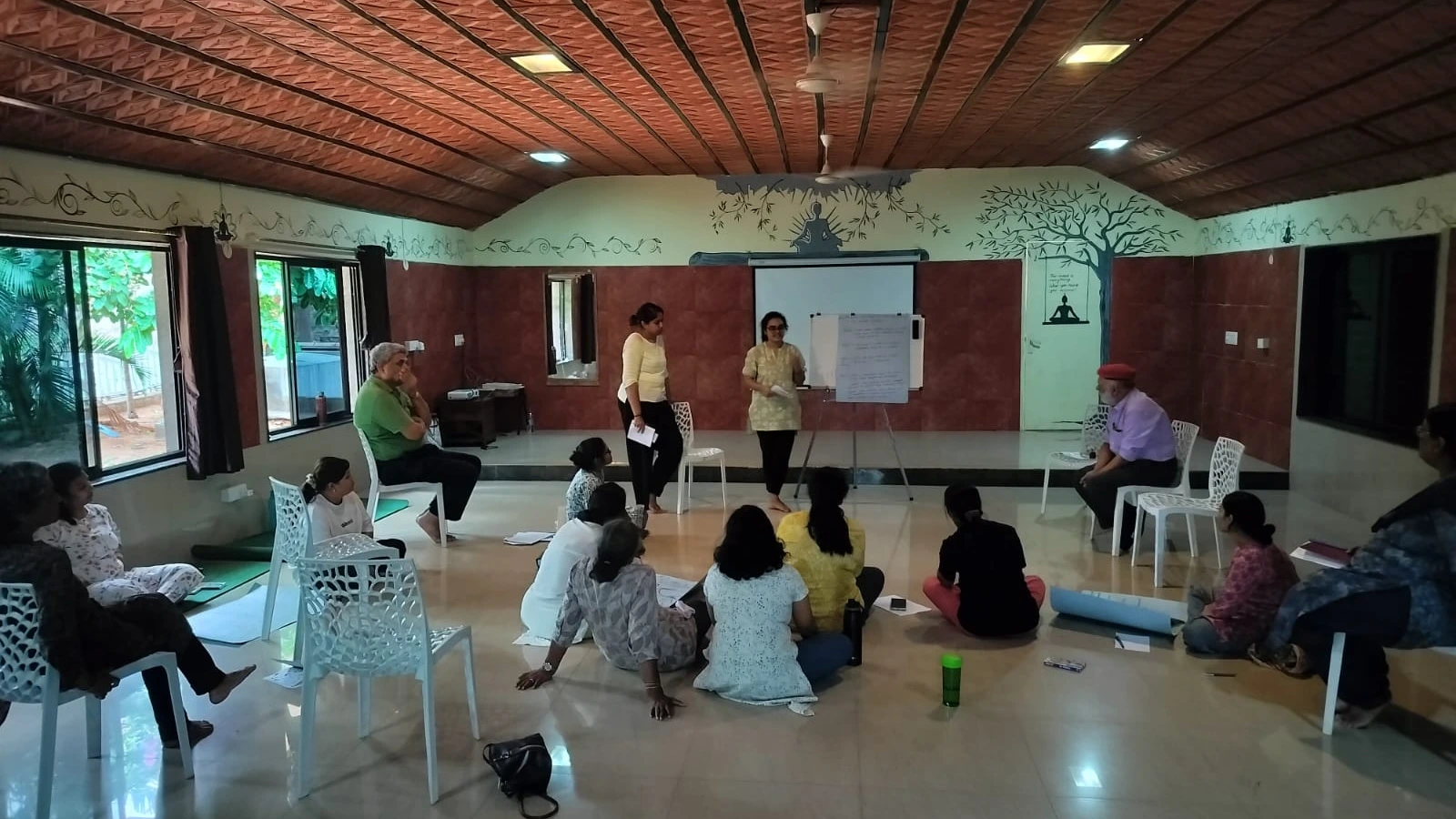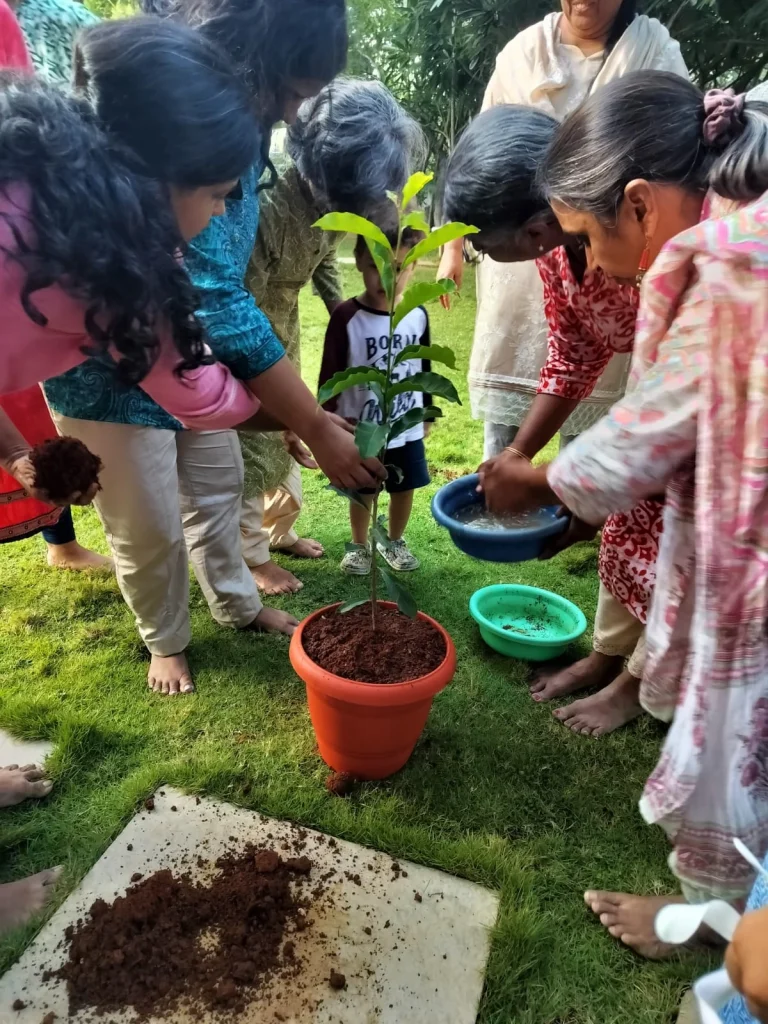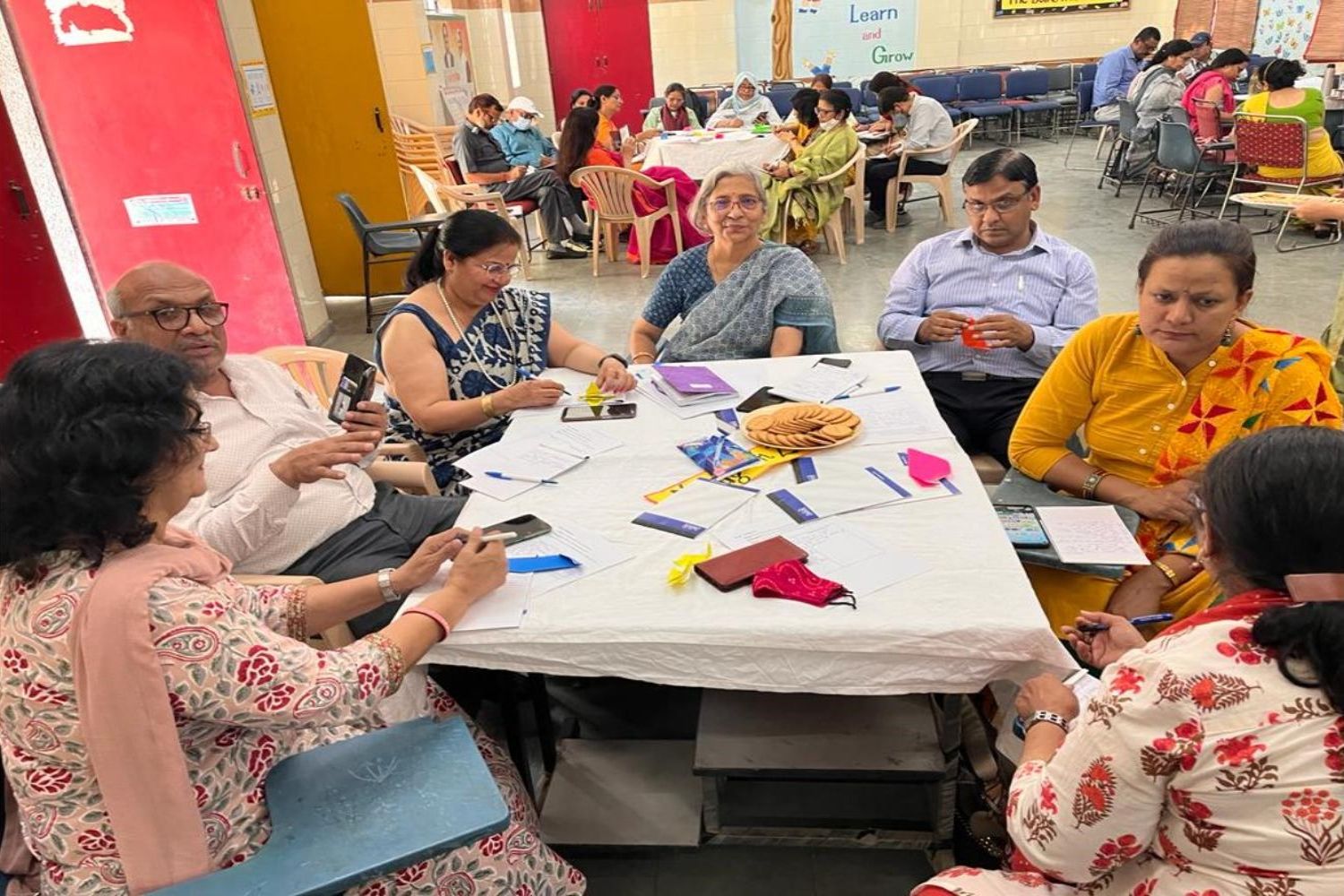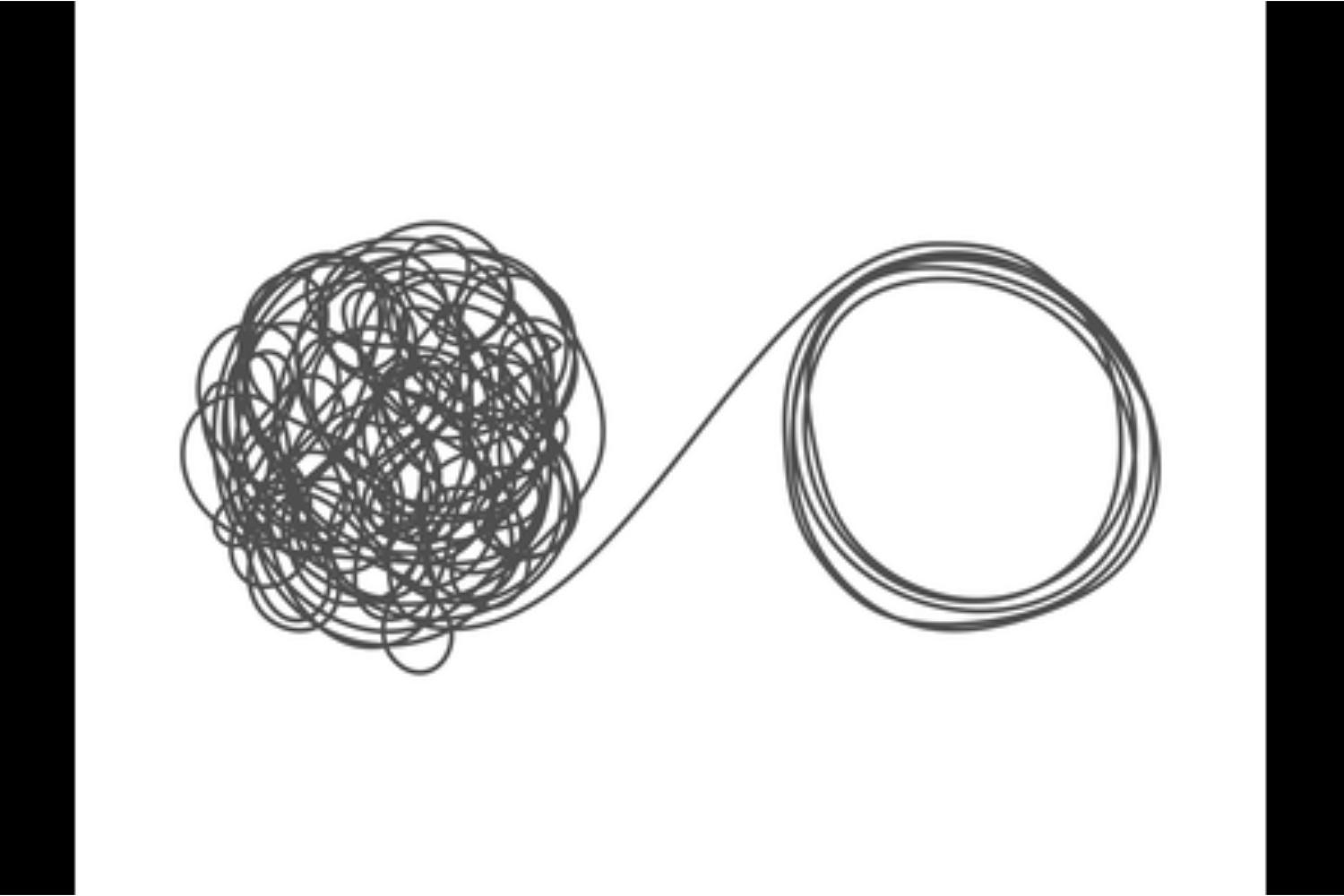A quiet transformation – from the inside out
Indira Vijaysimha’s essay titled “A quiet transformation – from the inside out” narrates an experience of what an unfolding journey toward well-being in the workplace looks and feels like.

Background
More than three decades ago, a sense of unease with the prevailing schooling system prompted me to quit teaching in a formal school and embark on a journey of learning with my three children. Tagore’s song, ‘Ekla cholo re’ comes to mind. This is because very few people in my circles in those days were willing to break away from mainstream schooling and try to operationalize a freer and learner-centric way of schooling children.
In today’s Bengaluru, there are many alternative schools. Newer ones are probably coming into existence even as I write this piece. In 1993, when people met the three children happily exploring their surroundings when other children were at school, they were quite incredulous to learn that these three were not in school but learning at home!
Thus began an exploration of education, inspired by the thoughts of Tagore and Gandhi, and informed by the writings of other thinkers like J. Krishnamurti, Montessori, Steiner, Rousseau, John Holt and Paulo Freire. Six months down the line, three more children joined this exploration. Their father, Prof. Darshan Shankar felt that the need for de-colonizing the Indian mind demanded that formal institutions in a different mold be created to serve as sustainable models for alternative ways of learning and education.
In 1995, a formal trust was registered under the name, Poorna. It symbolizes a holistic approach to education. It hoped to be a way of addressing the head, heart and hands through the learning process.
The initial group of trustees were all closely connected with the children’s learning as parents, guardians or interested neighbors. A friend and mentor from another alternative school associated with Krishnamurti’s philosophy also agreed to be part of the trust.
Organic growth vs. organization development
The small homeschool with six children grew in terms of the number of people involved – both children and adults. This necessitated an ongoing response in terms of selecting teachers and others who were aligned with the foundational vision. It wasn’t easy to pin down the intuitive sense of what it means to educate children in freedom, without simplistically adopting processes institutionalized by thinkers like Montessori, Steiner or Krishnamurti.
Always there were people who wanted to know what ‘kind’ of school Poorna was. There was in me a resistance to being labeled and to mechanically following a prescribed method. This is not to imply that approaches that were developed elsewhere could not be adopted to our situation. The key was to adopt processes that felt right in terms of our own understanding about education rather than to mechanistically resort to methods because they were employed by particular educational institutions.
This involved a continuous process of examining and re-examining what educating children to become happy and caring human beings meant in terms of curriculum and pedagogy. We had to keep alive questions about the reciprocal roles of the learner and the teacher. We also had to remain open to addressing the needs of diverse children.
Poorna’s vision of education for all also meant that we chose to be consciously inclusive, while facing up to the limits of our capabilities in terms of resources – both human and material. We were committed to admitting students from different social classes and, to an extent, students with special needs.
In the years prior to the Right to Education legislation, there was considerably more room to craft educational institutions in a multiplicity of ways according to the ideas of the founders. However, the much-needed RtE act was passed. It finally placed the accountability of educating our children squarely on the shoulders of the state governments.
One consequence of this was the increased bureaucratic control over schools. This reduced the space for educational experiments. Poorna, took the tough call to continue to function within the new regulations, while trying to maintain its initial vision of holistic education.

Personally, I felt the need to step away from the close, and somewhat emotional, involvement with the school’s day-to-day functioning. This was after nearly 15 years of struggling to put together the needed resources – both human and material.
I needed to distance myself. In my mind, the justification was that if the foundational ideas behind Poorna made sense to others they would carry it forward with me helping with clarifying the thinking and vision as and when needed.
Poorna had its own space. It also had a skeletal administrative staff and a sufficient number of committed teachers. The initial set of trustees had moved on in their lives. However, they continued to advice when requested, without undue interference or overt involvement.
After I stepped away to teach courses on education at Azim Premji University, the position of the school’s principal was filled by Renu Srinivasan for three years and then by Jayanthi Sachitanand and at present by Saira Banu. Each of these leaders brought their own strength to Poorna. I am deeply grateful to the ways in which each of them brought in different dimensions to Poorna’s organizational development.
The somewhat unplanned growth of Poorna as an institution has been referred to kindly as organic by those more charitably inclined. However, by some others like Gayatri, my daughter, and one of the first students of Poorna, it was perceived as haphazard and problematic.
Gayatri joined Poorna, after several years of experience working with international NGOs. She was distressed at what she saw as a lack of clarity about the vision, and the organizational processes that should flow from the vision. Listening to her, I felt that I had to re-insert myself back into Poorna and see if the drifting away from our core values could be corrected.
Dissonance
Apart from the problems that were articulated by Gayatri, I too began to hear the discordant voices. Poorna, that had begun with a hopeful vision of joyful learning, seemed to be slowly but surely morphing into just another sad little school where the main concern was about children scoring well at the board exams.
Still, of greater concern was the sense that Poorna as an organization had lost its focus of nurturing the innate learning abilities of children. Subjects were being spoken off as ‘scoring’ or ‘difficult to score high’, rather than as intrinsically relevant, interesting and worth knowing.
Teachers seemed to have formed their own little cliques. Discontent could also be felt. However, it was not voiced openly.
How could this have happened? Were people no longer connected with the initial ideal? Had the ideal itself lost its relevance?
The questions swirled around bringing with them a sense of puzzlement at best and a feeling of despair at worst. My personal sense of being able to find a firm footing seemed to give way to a sense of being caught in a marshy land with unknown hazards lurking underfoot and elsewhere! Gayatri kept suggesting that we need to seek help from organizational experts and, to be frank, this was anathema to me.
Corporate, for-profit institutions no doubt had worked out excellent ways of managing people to make their work efficient and productive. In addition to the considerable cost of hiring a consultant, I was skeptical about how these corporate ways of working could be of relevance to the work of teachers and others in school – that too in a school with strong humanitarian values that eschewed the notion of profit.
Part of the felt dissonance at school came from the conversations that seemed to center around salaries and benefits without a reciprocal sense of responsibility. Freedom was seen by both teachers and students as an invitation to shirk responsibility rather than as a way of taking one’s individual agency seriously and finding ways to collaborate and dialogue in ways that were deeply meaningful. The situation was far from ideal, especially in relation to the children’s holistic well-being.
What could relieve this cacophony of discordant voices? Did I simply have to shout louder and longer than everybody around and silence the protest? It was at this point that it occurred to me through a series of serendipitous encounters, which I will not describe here, that I could reach out to Shashi Nair.
I had known Shashi as a colleague at Azim Premji Foundation. I was also aware of his work in school leadership. Behind the corporate verbiage like “When the rubber meets the road”, Shashi has a deeply human side to him. He also has an undisguised concern for people’s well-being.
When I finally picked up the phone and made that call, I wasn’t surprised to learn that Shashi and Pramod were working on what they called the “Well@Work Lab”. Shashi, bless his heart, agreed to work pro-bono with Poorna about a year ago. After a few initial conversations, the next step was to schedule a series of online meetings with Poorna’s Board of Trustees, Saira Banu and Gayatri.
The tune re-mix!
They facilitated on-line discussions with the Board of Trustees. This brought back memories of the earlier days when the ideals that form the bedrock of our organization were still forming.
As we talked about our shared values, hopes and dreams, a fresh spring of energy opened up. The facilitators, Shashi and Pramod, skillfully steered us toward clearer articulations of what we perceived to be the problems and the key values.
Based on these values, they created a survey to gauge the extent of alignment with the stated values amongst selected staff members of Poorna. A common e-mail was sent to all the staff members. This asked for volunteers who were willing to lend their energies to bring in a greater sense of harmony at the workplace.
Nine staff members from the larger pool of teachers and administrative staff volunteered. This indicated that a lot of people were sensing that things were not going as well as they should.
The value alignment survey was sent out to the staff members who had volunteered. One of the strong recommendations that came from Pramod after analyzing the survey, was that we needed to come up with vision and mission statements.
Three of us – Gayatri, Banu and myself – spent two memorable days with Shashi Nair starting with a visioning exercise for Poorna. We then drilled down to come up with Vision and Mission statements.
The work was intense and even exhausting to some extent. In retrospect, I am so glad that Pramod insisted that the Vision and Mission statements should be compact – with strict word limits – unlike the earlier documents that had been written about Poorna.
One could say it was old wine in a new bottle. We did not so much deviate from the core values as much as re-articulate them with greater clarity. Having worked on the Vision and Mission statements we made some head way in paring down the list of core values to a manageable size.
The whole process involved going back and forth between the vision, the values and the ways in which the vision would work. As this work unfolded, one could sense how working with a shared purpose can iron away individual differences and bring in a sense of collective strength.
The next step that followed involved two long sessions with the staff members who had volunteered for the change initiative called Samarasa (Harmony). By the end of the two sessions, we had collectively arrived at a set of values and operating principles that could guide us toward putting the values into practice.
The document consisting of Vision and Mission statements, and values and operating principles that could now serve as a sort of constitution for Poorna. This document was shared with the Board of Trustees. They suggested that we call this document the “Poorna Way”.
Playing music together
If the Poorna Way can be likened to the basic scale of notes of a raga, then the staff involved in the change process can be seen as members of a music ensemble who needed to become familiar with the raga, develop the skills to interpret it and work together to produce musical harmony. A three-day intense retreat facilitated by the Well@ Work Lab team led by the master facilitators Shashi Nair and Pramod Athalye brought a deep shared understanding.
We had bared our inner selves in front of each other. We discovered that there was much in common between us. The way forward toward making music together, and enjoying ourselves as a community, necessarily involves a lot of practice.
The deep-rooted change that we were seeking would not shoot out of the ground like Jack’s magic beanstalk. The Samarasa initiative needed to be nurtured and cared for, just like the sapling that we symbolically planted at the beginning of the initiative.
Four teams, of three members each, were formed at the end of the retreat. Each team took up one operating principle to prototype for about a month. They tried to bring about perceptible behavioral changes.
In the process, we received wonderful support from Shashi and Pramod. This support was both open-hearted, generous and deeply skillful.
The Samarasa team met every week to reflect on the prototypes and the ups and downs involved in bringing about the desired changes. There were groans and the occasional moans. The school’s normal workload did not make the extra effort for Samarasa a cakewalk by any means.
However, the good thing that we noticed was that just holding ourselves to the schedule of weekly reflective meetings kept our energy and enthusiasm going. Finally, at the end of four cycles, we felt confident enough to open out the process to all the staff members to broad-base the cultural shift that was underway.
Gradually the Samarasa team has begun to own the process more fully. It also continues to improvise, as the work of prototyping continues. Shashi and Pramod were quite intentional in slowly stepping back while guiding team members to take up the role of facilitating the reflective sessions.
Sounds of music
For almost a year, we have been working to identify the changes needed, build up the momentum for change, and finally to start working to bring about change. Now, it does seem, we are beginning to work with greater harmony. The Samarasa team members have expressed that there is greater clarity about workplace values and operating principles.
There is a renewed sense of purpose in most of us. However, much of the mountain is still ahead. It is comforting to remind ourselves of Shashi’s words, “Instead of getting worried about the journey ahead, we can take heart from seeing how far we have come!”
It takes time to replace unhelpful habits and attitudes with a different set.
I believe that we are learning to do that. Personally, I am able to walk into school with much greater joy than before. My sense is that this is true for others as well.
This surely is a reflection more of an inner change than an outer one. I like to think that the inner and outer selves are mirrors of each other.
Parent teacher meetings have become more joyful already. It is as if the vision for 2030 that we collectively came up with has begun to influence the present!
Slowly, we have begun to involve more and more staff members into the work of prototyping the operating principles. I think this will help bring about the necessary changes toward greater well-being for all those working at Poorna.
The journey of a thousand miles begins with a single step!



No approved comments yet. Be the first to comment!